When Abby Gordon, a designer at Shepley Bulfinch in Boston, entered the competition to win her firm’s travel fellowship, she had only one destination in mind: Cuba. “I knew I had to go,” says Gordon, who has traveled extensively in Latin America and visited Mexico as part of a class at the Boston Architectural College (BAC) on Luis Barragán. Gordon’s BAC professors had previously taken students to Cuba, and she was enthralled by their photos of the island, as well as by Unfinished Spaces, a 2011 documentary about the National Art Schools outside of Havana, their astonishing brick vaults begun in the first flush of the Cuban Revolution and never finished.
Gordon won the fellowship, and in late June, she left Boston on a 30-day journey. She planned to trace the course of the revolution through the island and, of course, tour the capital of Havana. With its collection of Neoclassical, Baroque, Art Deco, and modernist architecture, Havana, founded in 1519, has “the most impressive historical city centre in the Caribbean and one of the most notable in the American continent as a whole,” according to UNESCO. The organization has named Old Havana a World Heritage site, along with the centers of three other Cuban cities: Trinidad, Cienfuegos, and Camagüey.

Matthias Schack via Flickr Creat
Panorama of Havana
Gordon’s timing couldn’t be better. In January, the U.S. government relaxed restrictions for Americans wishing to travel to Cuba, just a month after President Barack Obama restored diplomatic ties with the island nation. Between January and May, the number of Americans who visited the country surged by 36 percent, a Cuban economist told the Associated Press.
The ramifications go beyond the prospect of direct flights and weekend mojito breaks. Only 90 miles from Florida, with endless beaches and the still-unpolished jewel of Havana, the island beckons to real-estate developers and architects. With the easing of diplomatic relations, will Cuba soon become the next big emerging market for American firms?
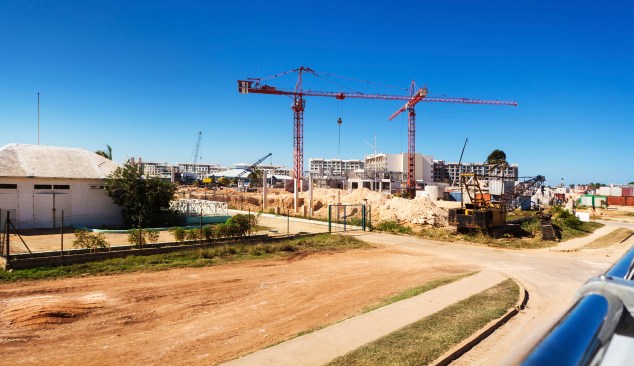
Igor Terekhov
Construction in the Cuban resort town of Varadero
The U.S. embargo, which prohibits Americans from spending money or doing business on the island, remains in place and has staunch defenders, like Florida’s Sen. Marco Rubio (R) and New Jersey’s Sen. Robert Menendez (D). Opinions differ as to its staying power. New York architect Belmont Freeman, FAIA, who is half Cuban and has spent considerable time on the island, thinks the fall of the embargo is inevitable. But, given the ill-will between Congress and the president, he says, “I have a feeling it won’t happen until the next presidential administration.”
On the other hand, Joseph Scarpaci, a geographer and professor emeritus at Virginia Tech who has written extensively about Cuba, says that hardliners in Congress will ensure that the embargo survives for the foreseeable future. “Obama’s announcement, it’s wishful thinking,” he says. He also points out that foreign investment in Cuba is nothing new; it began in the 1970s and gained steam in the ’90s. “Americans are late to the beach party, if you will,” he says. Spanish, French, and Canadian companies have long been building beach resorts and swanky hotels in Havana through joint ventures with the Cuban government. And much of the island’s waterfront access has already been sewn up, particularly on the northern shore. The beach town of Varadero, for instance, has numerous hotels operated by Spain’s Iberostar and Melia chains, and Canada’s Royalton brand runs resorts in both Varadero and Cayo Santa María.

Paraiso Azul Resort, a recent development on the Cayo Santa María, an island off the Cuban coast
A more promising opportunity for American firms may be medical tourism. José Gelabert-Navia, AIA, is the regional director for Latin America at Perkins+Will. He was born in Cuba, where his father, also an architect, held a prominent position in Fidel Castro’s government before fleeing to the U.S. (“He was very much with the revolution until he was against the revolution,” his son says.) Cuba has a lot of doctors, and they are renowned globally for their skill. “The level of education [in Cuba] is pretty high,” Gelabert-Navia says. “When we combine the fact that you have a country that’s only 90 miles away from the U.S., if you talk about doing hospitals, you know you can staff [them] with Cuban doctors.” Maybe, in a decade, some Americans will be hopping a flight to Havana for Lasik surgery or a facelift.
But Gelabert-Navia also envisions a growing market for new hotels as well as mixed-use and institutional projects. There’s hunger for it now, he says. “I’m getting calls, … ‘What are we doing in Cuba? Are we positioning ourselves to do something in Cuba?’ … My answer to all of them is: There is an embargo in place.”
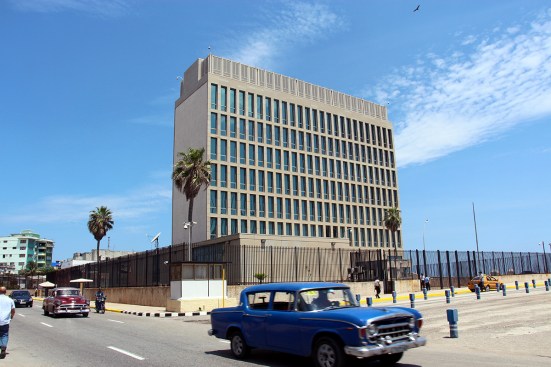
Isaac Risco/picture-alliance/dpa/Associated Press
The U.S. embassy in Cuba, recently reopened, was designed by Harrison & Abramovitz in 1950
Would-be investors would face other obstacles even if the embargo were lifted. Over the past several years, Cuban President Raúl Castro has instituted a series of economic reforms (for instance, allowing banks to make loans to individuals and Cubans to purchase real estate) that encourage investment and entrepreneurship. But Cuba is still tightly controlled by its Communist government. Joint ventures are how foreign companies can enter the island, and the terms are less than ideal: a 51/49 split, with the Cuban government retaining the majority share.
Cuba has no independent judiciary, no free press, and a long track record of seizing private assets. As recently as 2012, the government jailed several prominent foreign businessmen, including a British architect, Stephen Purvis, whose investment group Coral Capital had worked on hotel and golf course projects on the island; some were charged with spying or corruption after spending months in prison, then expelled from the country. Gelabert-Navia says his own cousin had his dairy-production plant confiscated by the government. “If the embargo [is] lifted, it’s going to be a complicated thing to give assurances that these investments are protected. That confidence has to be restored.”
Ultimately, Cuba may emerge from communism as China and Vietnam did, with a form of state-run capitalism fueled by foreign investment. Even now, on joint-venture projects, foreign architects team up with their Cuban counterparts, not unlike the Chinese system that pairs overseas firms with local design institutes.
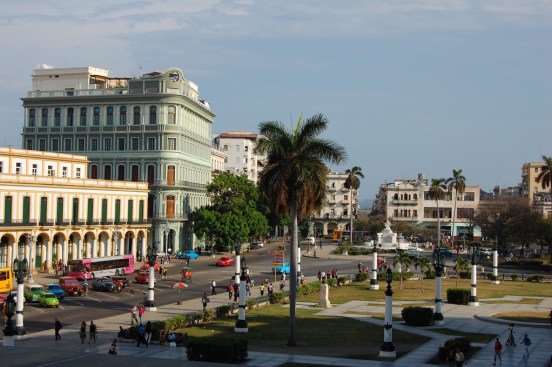
Corey Arnold
The Hotel Saratoga in old Havana, which the British architect Stephen Purvis helped restore before he was arrested and expelled from the country.
In any case, most architectural work in Cuba today focuses on the restoration of Havana’s immense historic building stock—two-thirds of which is in disrepair—and on bringing Havana into the 21st century without imperiling its heritage. That is the main worry expressed by many architects, including Freeman, who in a December 2014 essay in Places journal described Havana as “poised between two conditions of equal mortal peril”: not having enough money or getting too much of it too fast.
Cuba is a poor country, with an average income of $20 a month. Building collapses are common. When the Soviet Union disintegrated, so did the government’s main source of funding. Americans tend to romanticize scenes of Cuban life—vintage Buicks parked outside crumbling homes—and look past the deprivation they reflect. There is a clear need for capital. But development decisions need to be made with great care. “The urban fabric in Havana is intact,” says Julio César Pérez-Hernández, a Cuban architect, planner, and educator. “Havana survived the urban renewal phase—it skipped that.” After the revolution, Fidel Castro didn’t foist any grand urban renewal schemes upon Havana because he was more interested in redirecting resources to the countryside. So the city, Pérez-Hernández says, “was saved by default.”
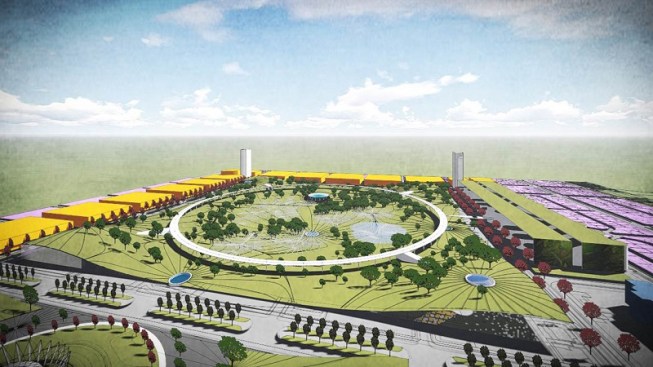
Héctor Gómez
A medical tourism campus envisioned for the Miramar district of Havana, a rendering from the 2015 Havana International Charette on Urban Design, organized by Pérez-Hernández
Since the 1990s, Cubans have made great progress in restoring Old Havana’s squares and landmarks. The official city historian, Eusebio Leal, is revered and surprisingly powerful, with a large budget and a staff of hundreds. Architects who have spent time in the country are encouraged by his leadership and Havanans’ pride in their architectural inheritance. “It is a very architecturally conscious city, sort of like Chicago,” Freeman says. “Everybody’s very proud of [its] beauty.” Still, Pérez-Hernández is worried about overdevelopment. “In six years from now, if it looks like Hong Kong … that completely changes the image of Havana.” His answer: an ambitious master plan that calls for revitalization of the waterfront (protecting the famous Malecón promenade against rising seas and pollution), a multimodal transit system, and more parks and public spaces. Pérez-Hernández began the project while a Loeb Fellow at Harvard University in 2001–02 and has refined parts of it with an international audience during a series of charrettes in Havana.
Pérez-Hernández spends most of his time in the U.S. The scarcity of Internet access can make working in Cuba difficult, and there are other severe constraints on the practice of architecture in the country, first and foremost that private practice is not strictly legal. In 2013, Raúl Castro expanded the list of private occupations that Cubans can hold to 201, including “dandy” (man dressed in colonial garb), taxi driver, restaurant owner, real-estate broker, and interior decorator—but not architect.
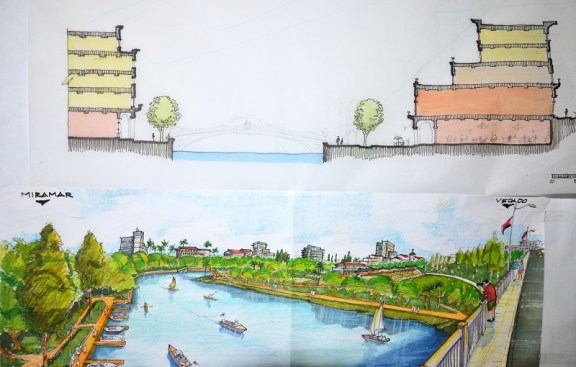
H´ctor Gómez
A river walk rendering from the 2015 Havana International Charette on Urban Design
Most Cuban architecture graduates end up working for government ministries, where they earn abysmal pay and often find their creativity stifled. Under-the-table work is common, however, and enforcement of the rules is spotty. It’s a fast-growing market. Foreign money—including remittances from Cubans living abroad—is buoying a new generation of entrepreneurs, who are paying architects to refurbish their homes or fit out paladares (family-run restaurants). Building materials are still nearly impossible to find or prohibitively expensive, but a new container-ship port at Mariel should soon bring in a steadier flow of supplies, reducing their price. In addition, the U.S. government just approved a plan by the Boston-based Finca Vigia Foundation to ship nearly $900,000 in supplies to Cuba to help build a facility to preserve Ernest Hemingway’s books, letters, and photos.
Still, many graduates of Cuban architecture schools are leaving the island in frustration. Pérez-Hernández reels off the places where his former students have moved: Florida, Virginia, New York, Mexico, Ecuador. If and when the private practice of architecture is recognized, more would stay, and some of those who have left would no doubt return.
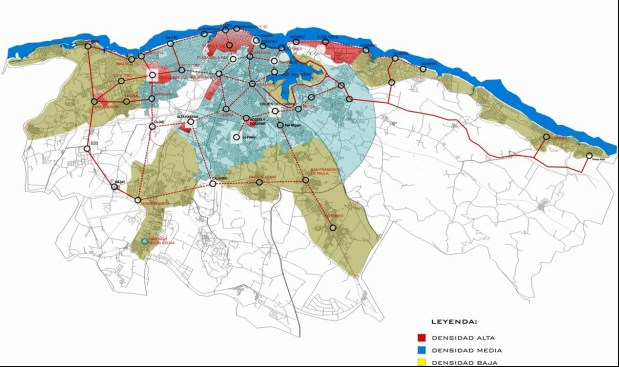
Julio César Pérez Hernández
A density map from Pérez Hernández's Havana master plan project
As Gordon prepared to fly to Cuba in June, John Pilling, a Boston architect who taught her at the BAC, returned from leading a people-to-people tour of Havana. Pilling used to run a joint studio with Pérez-Hernández: students at the BAC and at Cuba’s largest architecture school, the Instituto Superior Politécnico José Antonio Echeverría (or CUJAE), spent a semester working on a design problem in parallel, and then the Americans traveled to Cuba at the end of the semester. Pilling says graduates of CUJAE’s five-year course have skills that are roughly comparable to their American counterparts, but with one major difference. The Cubans, he says, have “an inherent understanding of how to build in the tropics with limited budgets.” (After the Bush administration set tighter restrictions on travel study, the studios stopped.)
But study-abroad programs are poised to grow again, especially because Americans now view Cuba more favorably than they have in 20 years, at least according to a recent Gallup poll. Nevertheless, many Cuban Americans—especially the older generation, and especially in Florida—remain strongly opposed to any engagement with the Castro regime. Cheryl Jacobs, the executive vice president of AIA Miami, plans to host a panel about American architects and Cuba’s future, a topic, she admits, that evokes “a lot of strong feelings” among local architects. Miami is home to the National Association of Cuban Architects, a group that describes itself as continuing in exile the pre-revolutionary Colegio Nacional de Arquitectos de Cuba (CNAC); one of its goals is to promote the restoration of democracy on the island. (My attempts to contact several members of the association’s board were unsuccessful.)
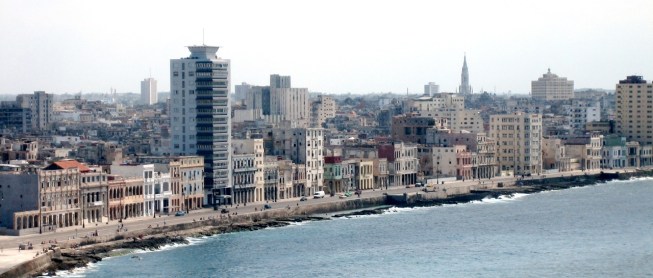
LukasMathis
Havana's Malecón
Younger Cuban Americans are more likely to support the new changes to U.S. policy, and in some cases, even their parents and grandparents have softened their stance. “For a lot of Cubans like my parents, that left because they were forced to … they came to the States with no money. They had to rebuild completely,” Gelabert-Navia says. “For that generation, the government in Cuba was evil personified.” Although he has had plenty of opportunities to visit Cuba, Gelabert-Navia never has, on account of his parents. “I always felt a sense of betrayal to them.”
Now, he says, his parents are older. They “feel they only have so much time left.” And they have asked to go back to Cuba, one last time.
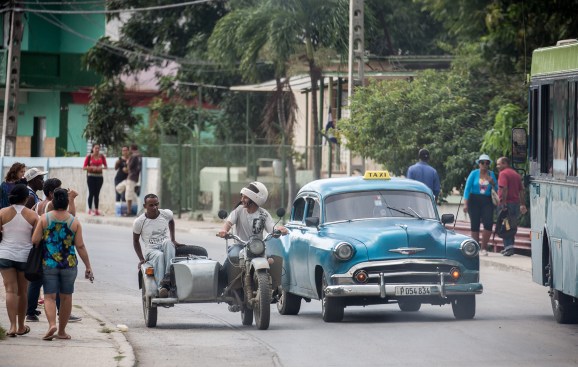
Michael Kappeler
A scene from the port town of Mariel
